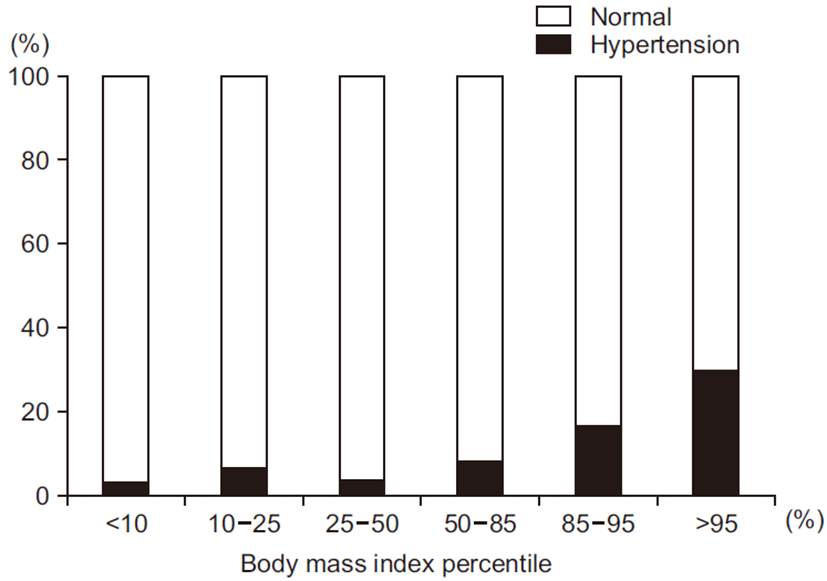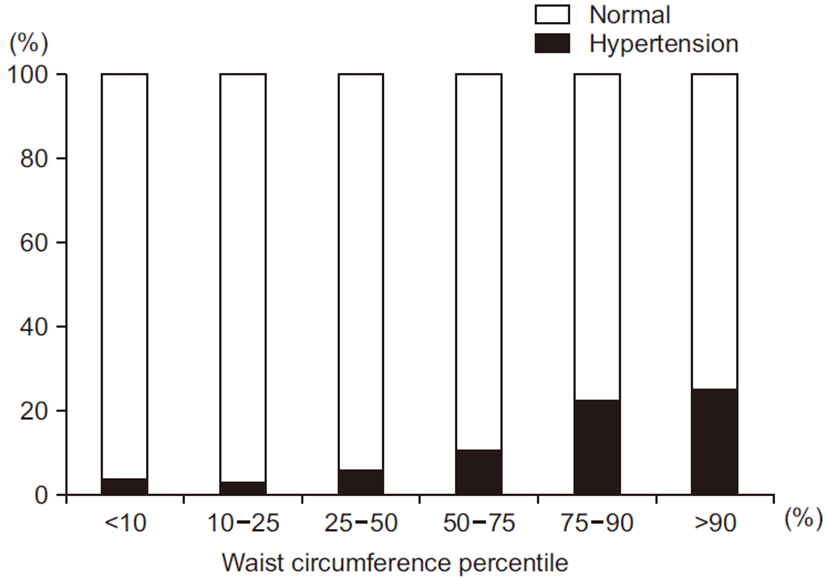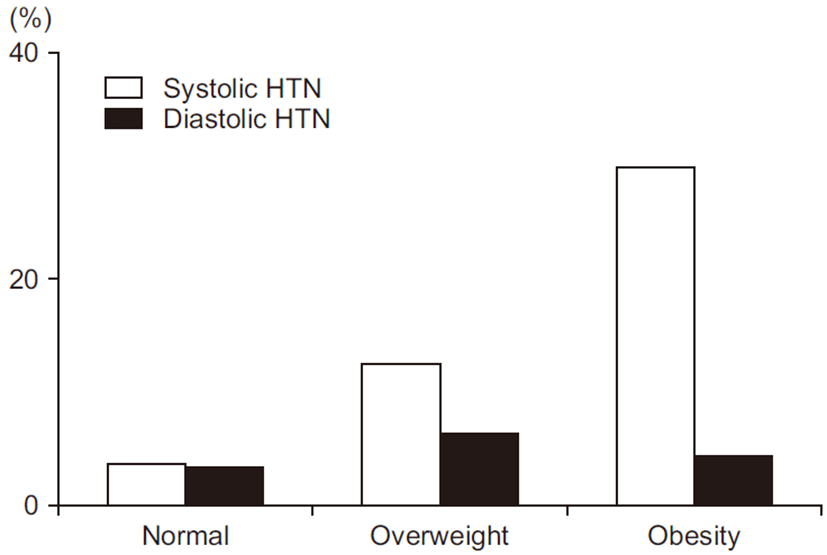Introduction
The prevalence of overweight and obesity is rising among children and adolescents in both developed and developing countries [1-3]. The World Health Organization reported that 18% of children and adolescents aged 5 to 19 were overweight or obese in 2016 Global Health Observatory data and the prevalence has increased at an alarming rate. The World Health Organization further projects that by 2016, the number of overweight children under the age of five, is estimated to be over 41 million and almost half of all overweight children under 5 lived in Asia. Accordingly, childhood obesity has become a public health crisis in Asia [4].
With the increased childhood weight problems, the prevalence of weight-related health conditions including hypertension is increased [2,5]. Because of the close association between blood pressure (BP) and obesity, the rapid increase in obesity may contribute to a raise in the prevalence of hypertension in children and adolescents [6-8]. Higher BP in childhood is predictive of sustained hypertension in young adulthood and a major risk factor for cardiovascular disease and is linked to cardiovascular morbidity [9-11]. In addition, once obesity-related hypertension has been established in adults, the control of BP is difficult to achieve because the mainstay of therapy must be weight loss [12].
The purpose of this study was to investigate the prevalence of prehypertension and hypertension in a high school students and to establish the relationship between obesity indices and hypertension. Furthermore, the effective interventions for prevention and control of adolescent obesity should be considered to prevent adult obesity and hypertension.
Methods
This study was conducted in March 2009 at a high school. A total of 429 adolescents (173 males and 256 females), aged between 15 to 18 years, were included in this study. Exclusion criteria included the self-reported presence of renal disease or cardiac disease. We classified as overweight if body mass index (BMI) was between 85th and 95th percentiles and obesity if BMI was ≥95th percentile for children of the same age and sex [13].
Abdominal obesity was classified as normal if waist circumference (WC) was below 75th percentile compared to >75th and ≤90th and >90th percentile for children of the same age and sex [14].
This study was carried out with the approval of the ethics committee of Ewha Womans University Hospital institutional review board, and written informed consents were obtained from the parents of all subjects.
Anthropometric data of weight, height, WC, BMI were collected from all participants. WC was measured using a metal anthropometric tape at the mid-waist point between the lowest rib and the iliac crest in a standing position at minimal respiration. BMI was calculated by dividing the body weight (measured in kilograms) by height squared (measured in meters).
Oscillometric devices, Dinamap Procare 200 (GE Inc., Milwaukee, WI, USA), were used for the BP measurements. BP was measured twice with a cuff of appropriate size on the right arm in a sitting position following a 5-minute rest period and averaged for a final BP reading.
Hypertension was defined if systolic or diastolic pressure was ≥95th percentiles for age, height, and sex. Prehypertension was defined if systolic or diastolic pressure ≥90th percentiles for age, height, and sex according to the normative BP reference for Korean children and adolescents [15].
Results
Anthropometric data of participants including weight, height, BMI, and WC are presented according to sex in Table 1. The age of all boys and girls were similar range from 15 to 18 years (P=0.536). The mean value of weight, height and WC of boys were higher compared to those of girls (P<0.001), but BMI was no difference between boys and girls (P=0.056).
The prevalence of overweight was 12.1% in boys and 10.5% in girls. The prevalence of obesity was 11.0% in boys and 10.9% in girls. The prevalence of abdominal obesity, which means over 90th percentile of WC was 13.3% in boys and 8.2% in girls (Table 2). The prevalence of hypertension was 9.2% in boys and 10.2% in girls and the prevalence of prehypertension was 14.0% in boys and 9.0% in girls.
The prevalence of hypertension and prehypertension according to BMI and WC percentiles shows in Table 3. The prevalence of prehypertension was 9.0% in the normal BMI group, 14.6% in the overweight group and 21.7% in the obese group and the prevalence of hypertension was 6.0% in the normal BMI group, 16.7% in the overweight group and 29.8% in the obese group. Based on WC percentile, the prevalence of prehypertension was 10.0% in the normal group, 11.1% in the 75th to 90th percentile group and 18.6% in ≥90th percentile group and the prevalence of hypertension was 6.2% in the normal group, 22.2% in the 75th to 90th percentile group and 25.0% in ≥90th percentile group.
In addition, the distribution of hypertension according to BMI and WC percentiles shows the relationship of obesity with high BP. The more BMI percentiles increased, the prevalence of hypertension increased (Fig. 1). Similarly, the more WC percentiles increased, the prevalence of hypertension increased (Fig. 2). The prevalence of hypertension was markedly increased, especially in above 85th percentile of BMI and above 75th percentile of WC. Increase in BMI and WC is associated with increase in the prevalence of hypertension.
The prevalence of systolic hypertension was 3.6% in the normal group, 12.5% in the overweight group and 29.8% in the obese group (P<0.05). But, the prevalence of diastolic hypertension was 3.3% in normal group, 6.3% in overweight group and 4.3% in obesity group (P=0.305). The results shows that obesity affects systolic BP more than diastolic BP (Fig. 3).
We used logistic regression analysis to obtain odds ratio and to assess the association between obesity and hypertension (Table 4). In univariate analysis, the significant risk factors of hypertension were obesity and above 75th percentile of WC. The risk of hypertension was 5.53 times higher with obesity, 2.04 times higher with overweight and 3.93 times higher in above 90th percentile of WC. In multivariate analysis, obesity was significantly risk factor, which was 5.21 times higher in the prevalence of hypertension.
Discussion
The increasing prevalence of childhood obesity is a worldwide trend and becomes a significant public health problem [2,16]. The Global Burden of Disease 2013 Obesity Collaboration reported that the prevalence of overweight and obesity was rising among children and adolescents, increasing from 8.1% in 1980 to 12.9% in 2013 for boys and 8.4% to 13.4% in girls for 21 regions in 188 countries [7]. As Korea had been developing, obesity increased rapidly from 1979 to 2002 and the prevalence increased from 11.0% to 17.9% in boys and from 9.0% to 10.9% in girls [17]. And in Korean, the overall prevalence of overweight and obese adolescents increased from 6.8% in 1998 to 10.0% in 2013 [1].
In our study similar results produced that the prevalence of overweight was 12.1% in boys and 10.5% in girls. And the prevalence of obesity was 11.0% in boys and 10.9% in girls. This study provided data on the association of increased BMI and WC with high BP in adolescents from high school students. As BMI percentiles increased, the prevalence of hypertension raised from 3.2% to 29.8% and most rapidly increased in the last highest 15 percentiles group, which showed over 5 times to 9 times higher. Similarly, children with BMI over 85th percentile demonstrated that the risk of hypertension were 4-fold higher [18]. The prevalence of hypertensive range diastolic BP in normal versus obese BMI girls was 1.4% versus 12% and 3.5% versus 15.2% in boys, which represented significant association between obese and hypertensive BP [19]. As WC percentiles increased, the prevalence of hypertension increased 3.7% to 25% and showed the peak level in group where defined as abdominal obesity. Rosa et al. [20] also reported that there was a statistically significant association between WC and hypertension based on the prevalence ratios in Brazil with children and adolescents.
The results indicated that obesity or abdominal obesity adolescents were at a substantially increased prevalence of hypertension. The current study found that overweight, which odd ratio were 2.04 and 2.13, made the risk of hypertension twice higher and obesity, which odd ratio was 5.53 and 5.21, made the risk of hypertension 5 times higher. Dong et al. [7] reported that odd ratio were 4.1 in obese boys and 4.0 in obese girls, which meant overweight and obese children had about 4 times higher in prevalence of high BP than normal weight children. Thus increased BMI and WC are good predictors of the risk of development of hypertension in adolescents. As a results, two variables are clinical useful points in risk identification of hypertension.
In addition, this present study findings indicated that the prevalence of systolic BP appears, which were 12.5% in overweight group and 29.8% in obese group, were more than that of diastolic BP respectively 6.3% and 4.3%. Similarly, Sorof et al. [21] reported that the prevalence of systolic BP were higher than that of diastolic BP in obesity group. In the same study, the prevalence of isolated systolic hypertension among adolescents who were both obese and had BP above the 95th percentile was 94%.
Limitation of this study was that BP was measured with automated oscillometric device which could be prone to errors when there were too much patient arm movement or the use of inappropriate cuff size. Another limitation was white coat effect, which is a phenomenon that BP level is above the normal range when measuring with personnel wearing white coats in a clinical setting than when taken at home [22,23].
Overweight and obesity in childhood had a significant impact on physical health and associated with the development of hypertension, which could lead to cardiovascular diseases including coronary artery disease, cerebrovascular disease, renal insufficiency, atherosclerosis, left ventricular hypertrophy, atrial fibrillation, and congestive heart failure [12,24,25].
In conclusion, this study emphasized the importance of check BMI, WC, and BP regularly in order to assess the risk of hypertension and follow up carefully. Anthropometric data which are very non-invasive way can be used to recognize the status of children at risk of hypertension. Hypertension is not only an adult disease but also can become children disease which are a potential state at present. Furthermore, we should make efforts to make preventive strategies of adolescent obesity to avoid a future unfavorable epidemic of adult cardiovascular disease. Further study is required to assess the effect of preventive strategies and to find other risk factors of hypertension among Korean children and adolescents.


